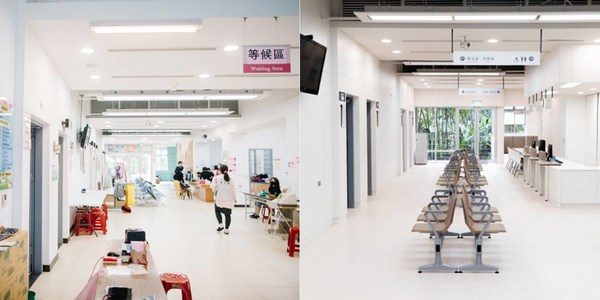TAIPEI, May 7, 2021 /PRNewswire/ -- Taiwan Design Research Institute (TDRI) cooperates with New Taipei City Department of Health for the "Public Health Center Re-Designed" project, hoping to make use of design to turn the image and service efficiency of public health institutions around. In Taiwan, the KPI of every public health center is to complete 300 services a year. TDRI first launches demo projects at Xizhi District Public Health Center and Yingge District Public Health Center that service large populations, in which TDRI conducts preliminary service design research and then hands over to local design teams "S. Select Lab" and "Zuo Studio" for overall visual and spatial planning.

The picture on the left shows a traditional public health center in Taiwan; the one on the right is a public health center re-designed by TDRI.
Throughout the course of life from birth to death, which place is the most closely related to our daily life? It is not some popular trendy cafés or Michelin-starred restaurants with long queues, but the often overlooked public health centers in our neighborhoods. From vaccinations for infants, health education for newlyweds, to regular checkups for elderly citizens, all these are conducted in public health centers.
However, when people think of those public health centers near home, they often give the impression of being old, dim, with walls full of health education posters; with unclear signs and instructions and bad traffic flow design, citizens all squeeze in front of the registration counter, and staff members and volunteers are exhausted answering their questions. Consequently, there is a long queue for every service, affecting the service efficiency and capacity of public health center. Moreover, with the rise of preventive healthcare in recent years, and growing demand of elderly care, all public health centers across Taiwan are seeing growing workloads, further straining public health centers' utilization effectiveness and spatial affordance.
The design planning focuses on a number of key areas. First, color scheme. In the past, public health centers had no consistent colors, whereas now, neutral and natural earth tones have been used to recolor the space into beige, grey, and khaki, while also defining the waiting areas, consulting rooms, and independent spaces (such as health education rooms and counseling rooms). Senior-friendly desks and chairs that can be easily moved around are also used to give the overall space consistency, and inject a sense of warmth and peace of mind.
Second, service design. Traffic flow is reexamined. Through design, people are evenly distributed to all areas, and the overall service flow is expedited. The final and most-important area is modular design. Modularized walls are used in combination with signage design and furniture that can be freely adjusted to create a space that is vaccination room in the morning and health education room in the afternoon, meeting health public centers' demand for versatility and flexibility.
Furthermore, modularization is also applied for spatial replicability. TDRI hopes that this project can set a new paradigm for the future. This demo project can be flexibly replicated to over 350 public health centers across Taiwan, or even overseas. This project is not just a project of public service design, but also a paradigm of interdepartmental cooperation, offering countries around the world that are in dire need for improved public health service efficiency a quick and effective solution.